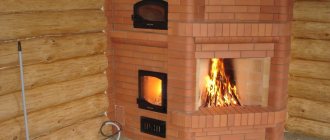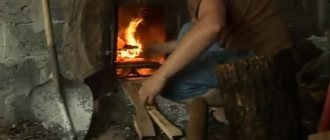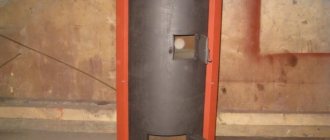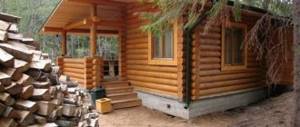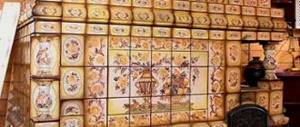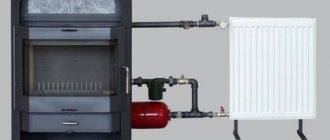- home
- Services
- Sauna stove heater
For true connoisseurs of the Russian bath, we offer to build a real sauna stove, popularly called a heater stove. We will help you choose the optimal model. It is also possible to combine a sauna stove with a fireplace or fireplace stove, or equip a panel for heating the second floor with the heat of a sauna stove. Contact us.
Call or write to us for details (Sergey), (Alexandra) /
The stove's task is not an easy one - you need to heat the steam room well, and also heat the stones red-hot to make the steam light and pleasant. It’s hard on the stove, it has to be kept at a high temperature for a long time, it has to cope with high humidity, and it’s also pleasing to the eye. Therefore, by design, sauna stoves are the most complex, the slightest misdeed by the stove maker will immediately come to light - the brick will crack, the thick seam will come apart... and then remember the name of the stove along with the sauna. But a good stove maker will not allow this, he is attentive to his work, he loves his creation and is proud of every stove.
Advantages of the stove - heater
| 1. | Optimal temperature The heater warms up the steam room well, providing a temperature of 60 - 80 degrees, which at 60% humidity is considered the most optimal for bath procedures and does not harm your health. |
| 2. | High quality steam Water vapor, it turns out, comes in different forms. At 100 degrees the water begins to evaporate, but this steam is heavy. At higher temperatures, water is atomized into smaller fractions, producing increasingly lighter vapor the higher the temperature. And the stones in the heater heat up to 800 degrees. Can you imagine the light steam that is produced when water hits such stones?! Therefore, it is easy to breathe in the steam room. |
| 3. | The oven is hot, but moderately The heater is designed for high temperatures and is protected from overheating. The walls of the stove are brick, and even double-layered, and heat up no higher than 90 degrees. You will not get burns or heatstroke near such a stove. The warmth radiates soft and gentle. |
| 4. | Time The sauna stove will not cool down with just one ladle of water. She is capable of more. The first day after kindling the temperature stays around 80 degrees, on the second day - 50 degrees. So you don’t have to rush, you’ll have time to steam up and drink kvass. |
| 5. | Fire safety The outer walls of the stove are protected from overheating by fire-resistant bricks, the wooden structures are separated by fire-resistant cuts, the chimney is lined with a stainless steel pipe, all the doors are securely fastened, so there is no need to worry. The fire is only in the stove, and the smoke is only on the street. |
About continuous and intermittent firing furnaces
It is clear that stones placed on a grate become much hotter, and are also heated by smoky gases passing through their thickness. At the base of the backfill of a periodic furnace, the temperature can reach 1100ºС, and at the top of the pile of stones 600ºС. The stones sometimes become heated to a purple glow, and the water splashed on them turns into soft, finely dispersed steam that does not cause burns or make breathing difficult.
Pros and cons of furnaces depending on operating mode
On a monolithic or two-part slab, the stones will not “accumulate” a temperature above 350ºC. Therefore, the steam of constant-fired stoves is not soft. And if safety rules are not followed in bathhouses with such heat generators, burns occur not only to the skin, but also to the nose and upper respiratory tract. Infrared radiation from electrical equipment can produce a characteristic red mesh on the skin. However, permanently fired stoves have many adherents because they:
- are the optimal choice for small personal baths, because... occupy a minimum of space;
- do not require the construction of a separate foundation necessary for the installation of heating equipment weighing more than 700 kg. To install them, it is enough to strengthen the floor in the location area by installing additional logs;
- easier to manufacture, especially if the owner of the bathhouse plans to equip it with his own hands;
- the cheapest option;
- heat the room faster than competitors of intermittent combustion.
The downside is the formation of heavy steam, but only they are suitable for arranging a miniature bathhouse. To prevent contact burns, it is recommended to make a wooden fence around the structure. A metal bath heater, as well as a metal chimney, according to SNiP 2.04.05-86 regulations, must be located 70 cm from vertical combustible surfaces and structures. There must be at least 125 cm between the firebox and the opposite wall. Between the upper ceiling and the upper plane of the stove there must be at least 80 cm, and if the ceiling is not protected from the threat of fire, then 120 cm.
Owners of spacious baths naturally prefer brick stoves with intermittent combustion. They may be large and expensive, but they are the only ones that generate light steam. The disadvantages include:
- massiveness, requiring the mandatory construction of a separate foundation that ensures independent shrinkage. Brick stoves weigh on average 1200-1350 kg, depending on the specific gravity of the material. The larger the number in the marking, the greater the density, which means the mass of the brick;
- impressive dimensions, taking up a lot of space for steamers;
- a long heating period, taking at least 3 hours, but justified by the long cooling of the stove and the ability to undergo several procedures for two or three families;
- it is impossible to add fuel to the stove during the procedure if it is not heated enough;
- the complexity of construction, very difficult for an inexperienced performer.
The distance between flammable vertical surfaces and the walls of the brick stove must be at least 40 cm. The top of the brick stove can be removed from the ceiling with fire protection by only 25 cm, and from the unprotected ceiling by 35 cm. If the surfaces around the bath unit are upholstered with sheet iron or with asbestos cardboard, the distance between the stove and the partitions, between the top and the bath ceiling can be slightly reduced.
If the grate of a periodic combustion unit is supplemented with an impenetrable horizontal partition, then it will be able to function in both constant and periodic combustion modes. Stoves of this type are classified as combined action units. Studying the drawing of this type of sauna heater will help you understand what the difference is. They are mainly built of brick, but there are also metal structures.
The main task is to increase the heat capacity, which is achieved by increasing the dimensions of the unit and the size of the stone backfill. A design that is too complex, requiring precise calculations, is not in demand among independent craftsmen who prefer simple, accessible solutions.
Video master class on making a metal stove:
Water containers and heaters
Most often, brick heater stoves are built with a built-in water tank, which can be bottom, side or top. A gap is left between the built-in tank and the brick walls for the thermal expansion of the metal elements. Often a boiler or closed tank with a tap is simply installed on the stove. The upper tank, located around the chimney pipe , works well; it heats the water like a samovar. The container for collecting heated water can be located separately from the stove if there is a coil in its firebox connected by a pipeline to a separate tank.
The rules for positioning the tank of a periodic furnace are no different. The principles of constructing closed and open stone backfills are similar. For both types of heating units, the heater can be open, in which the stones lie on the upper surface in a heap, or closed, i.e. covered on top with a rounded vault or several rows of brickwork.
Distinctive features:
- the first open version of the stone backfill is equipped with a removable metal lid, which is removed to supply water to the stones and returned to its place after steam has formed, so that the heat of the stones is not wasted;
- a closed heater is equipped with a window-type opening with a door for supplying water to the stone backfill. Cast iron stoves with burners are considered a good device for constructing a closed steam chamber with an upper hatch. By the way, they are often used as impenetrable horizontal partitions for permanently fired stoves, on which the stone backing is supported. The presence of burners has virtually no effect on the solidity of the cast iron stove.
Most often, lovers of bathing procedures prefer an open heater, which allows them to admire the hot stone pile. A stove with an open heater heats the room faster, but does not retain it for as long as a unit with a closed steam chamber.
Tips for beginner stove makers
- Before building a heater for a personal bath from brick or sheet metal, you need to make a drawing with dimensions. You can use standard drawings.
- Under the brick oven you need to make a monolithic concrete or rubble concrete foundation. If the soils surrounding the foundation are dry, it can be built of brick using a lime or cement mixture. In plan, the foundation should be 5 cm larger than the outline of the stove on all sides.
- When the top of the stove foundation is level with the floor line, it is leveled with a cement mixture, and roofing felt waterproofing is laid on top in 2 layers.
- The stove is built not in segments, but in complete rows, using a mixture of equal parts of clay and sand. The thickness of the seams is no more than 3 mm. You cannot tie bricks of different quality in adjacent rows.
- The grate is located at a height of 1 brick.
- The optimal dimensions of the opening of a wood-burning firebox are 25 cm height x 35 cm width, the length of the firebox is from 40 to 60 cm.
- The pipe for a sauna stove is most often made as a top-mounted one, i.e. installed on the stove. A gap of 10 cm must be left between the brick pipe and the wooden elements of the ceiling and roof. When a metal or asbestos-cement pipe passes through the roof, the adjacent elements are covered with felt impregnated with a clay solution.
- Floors made of flammable materials, regardless of the type of stove, must be protected by first laying asbestos cardboard, then sheet roofing steel with a strongly recommended thickness of 10 mm. In front of the firebox there should be a metal sheet 50x70 cm, located with the long side along the stove wall with the firebox.
Construction of a sauna stove
A brick stove is heavy. 1500 - 2000 bricks are needed for such a furnace, and this is 6 - 8 tons of weight. Therefore, a reliable foundation is necessary. And since there is a foundation worthy of such a stove, then we get to work.
The heater stove is laid out in 2 stages. First, the fireclay core is made; this is not only the firebox, but the entire furnace. Next, the core is scalded with a metal frame so that the corner bricks do not try to crawl out. Next, the fireclay is covered with basalt cardboard and lined with high-quality ceramic bricks. All oven doors are also attached to the outer wall.
The heater consists of three chambers: a firebox, a stone filling and a heating bell shield. Each chamber has special cast-iron doors: in the firebox - for storing firewood, in the stone filling - for pouring water on the stones and generating steam, in the chambers of the shield - for cleaning it from soot and warming up the steam room.
For laying, the stones used are not simple ones, but those that are highly resistant to high temperatures, such as crimson quartzite and gabbrodiabase.
According to their design, heater stoves are of open and closed type.
Metal stoves
For centuries, stoves in wooden houses were made of bricks. The heating of the room was powerful and lasted for a long time, but preparing the bathhouse for use took a lot of time, and the consumption of firewood was very high. Progress does not stand still, and metal stoves have replaced brick stoves.
What are their advantages?
- A metal stove is much more compact, quicker to install, easier to maintain, and does not require much wood consumption.
- Wide range of ready-made stoves.
- High warm-up speed. It takes no more than an hour for the steam room to heat up to 110°C.
The Teplodar metal sauna stove is an excellent solution even on a moderate budget. Below we will look at the most popular models in this line.
Open type heater
This is a kind of hybrid between a brick and an iron sauna stove. With its advantages and disadvantages.
The stones are not located inside the oven, but outside, in a special stainless steel box. Fire and smoke do not pass through the stones; the stones are heated through the walls of the metal box, figuratively speaking, the stones are fried in a large and deep frying pan. We build stoves of this type based on the developments of I.V. Kuznetsov under the name: Russauna bath stove.
| Advantages | Flaws |
| The stone backfill always remains clean. | The temperature of the stones is lower than in a classic heater - 200 - 300 degrees, the steam is not so light. |
| We lit the stove and after an hour and a half you can already go steaming, adding wood to the stove as needed. | Keeps warm for less than a day. |
| Obtaining higher temperatures in the steam room, up to 90 degrees, due to exposed stones and metal. | The high cost of making a box for stones from high-quality stainless steel. |
| The stone backfill always remains clean. | |
| We lit the stove and after an hour and a half you can already go steaming, adding wood to the stove as needed. | |
| Obtaining higher temperatures in the steam room, up to 90 degrees, due to exposed stones and metal. |
Assortment of metal stoves for baths "Teplodar"
Today it offers customers 14 lines of stoves. The products of each of them are presented in several options, differing in size, weight, and technical characteristics. Below are some types of heater stoves:
- “Taman”, “Taman-Setka”, “Kuzbass”, “Kuzbass-Optima” - budget options with thick walls, suitable for small double rooms;
- “Cascade”, “Laguna”, “Rus”, “Sahara”, “Siberia”, “Domna” - closed or open type structures for a medium-sized Russian bath;
- “Domna-Setka”, “Rus-Setka”, “Sibirsky Utes” - ovens with a grid into which stones are placed (on one or several sides);
- "KomPAR" - gas stoves for baths and saunas "Teplodar" - are usually used for commercial purposes.
Fast and efficient heating of the steam room with minimal fuel consumption is a common feature of the above devices. Let's take a closer look at the characteristics of some stoves.
"Rus"
The technical characteristics of the product are as close as possible to the traditional Russian sauna stove. Good heat retention, a large amount of light and pleasant steam - these needs will be fully satisfied by "Rus".
Stove for baths and saunas “Rus” Panorama
The operational advantages of the stove include:
- convection heating system (there are holes for warm air circulation);
- spacious firebox;
- uniform heating of air and stones;
- self-cooling door, allowing you to touch it without the risk of getting burned;
- thoughtful ergonomic design.
Today, the Rus stove is consistently one of the most popular metal heaters in the assortment among consumers.
The “Rus” stove with the “Panorama” index is a successful modification of the previously described series, developed in 2007. It occupies a leading position in the segment of luxury equipment for saunas and baths.
A distinctive feature is the presence of a built-in steam generator with a water dispenser. The device allows you to try different vaping modes. Large heat-resistant glass turns the stove into a stylish element of the interior and allows you to admire the flames.
"Taman"
Stove for baths and saunas “Taman”
This model is capable of quickly heating the air in a steam room to 110°. Additional attention of the designers was paid to a more efficient exit of flue gases. More heat is transferred to the stones, and infrared radiation is less intense.
"Taman" is characterized by an optimal combination of price and quality. The depth of the firebox is 40 cm, which allows you to heat the stove with fairly large wood. The heater is equipped with a removable water heating tank with a capacity of 40 liters.
"Kuzbass"
Stove for baths and saunas “Kuzbass”
A good alternative to the previously described models if it is necessary for the stove to be located in the corner of the steam room. The wall thickness is up to 8 mm. The heat produced by coal is stronger than that produced by wood. Additional protection is achieved by 4 mm thick inserts (not included), which remove heat and protect the stove from premature breakdowns.
The stove stove can be open or closed. There is a self-cooling door with a reliable locking mechanism.
"Kuzbass-Optima"
Stove for baths and saunas “Kuzbass Optima”
This model retains the wall thickness and the possibility of additional protection, but there are no stainless steel elements. This solution simplified the design and reduced its cost.
The fuel options used are wood and coal. Most modifications are equipped with an open heater, series 14 and 20 are equipped with a closed one.
"Siberia"
Stove for baths and saunas “Siberia”
If the speed of warming up the steam room is important to the consumer and the classic dry sauna mode is preferred, “Siberia” will be the best choice - it heats up to 110°C in half an hour.
The model is widely in demand in the Russian Federation and neighboring countries. Often purchased commercially for installation in Finnish saunas.
"Sahara"
Stove for baths and saunas “Sahara”
A universal stove capable of creating both the humid microclimate of a classic Russian steam room and soft dry steam. The design of the heater has two chambers, heated from five sides.
The model has a central chimney, which makes installation easy. There are modifications with a steam generator, which allows you to configure the desired vaping mode. There are no sharp corners in the design, and the dimensions of the device allow it to be used even in compact baths.
Closed heaters
This is a type of classic heater stove. The stones are located in a special chamber inside the furnace, and are heated by an open fire through a separating grate made of cast iron or fireclay. When wood is burning in the firebox, it’s too early to steam, because if you open the door of the stone lining, the smoke will go into the steam room. You need to heat the heater for 4 - 5 hours, until the stones are red-hot and all the soot in the chamber burns out, and let it sit for another hour or two, and then you’re welcome. But it's worth it.
| Advantages | Flaws |
| Stones heated to 800 degrees produce very light steam. | The stove needs to be heated for 4-5 hours until the stones are red hot. |
| The stove holds heat perfectly for 2 days. | |
| The optimal temperature in the steam room is 60 - 80 degrees. |
Requirements for a stove
Each stove from Teplodar combines reliability, functionality, stylish and ergonomic design. With its help, you can produce dry and wet steam, and heat the air in the steam room to 110°.
The wood-burning sauna stove “Teplodar” is characterized by the following advantages:
- compactness - the product takes up little space and does not interfere with movement around the steam room;
- strength - the furnace body is made of heat-resistant steel with a sheet thickness of 2.5 and 4 mm, depending on the modification;
- A spacious firebox that can easily accommodate large firewood.
In addition, Teplodar stoves are easy to use, economical, durable, and installation takes a minimum of time.
The best manufacturers
Wood-burning sauna stoves are available for sale in a huge range. And thanks to the instructions for self-welding and laying, such products can be made independently at home, which will significantly save money. Everyone decides for themselves what to do in such a situation, based on their budget and personal desires. Reviews from real users indicate that there are currently 2 manufacturers of sauna stoves leading the market.
There is also more than one company producing these furnaces.
Company Harvia
This company has a huge selection of models that differ in function and design. Here, any buyer is able to choose for himself, without any problems, exactly the option that will fully meet his desires and goals. The company offers its customers both conventional floor designs and designer stoves that can be placed in a corner or on a wall.
Models from Harvia have proven themselves to be the best due to their high quality, long-term operation and operational reliability. In the production of fireboxes , modern durable materials are used, namely steel , the thickness of the upper part of which does not exceed 1 cm, which guarantees the strength of the heater and a long period of operation.
Which sauna stove to choose cast iron or steel:
Manufacturers coat the outer casing with fire-resistant paint, which is able to maintain its original quality characteristics for a long time.
The company’s assortment also offers a number of different additional elements that will harmonize perfectly with the stoves presented, and will also contribute to a significant increase in their functionality and performance.
Helo Company
The manufacturer has proven itself from the best side due to the fact that the range includes both budget models and luxury options for true bath connoisseurs. The best types of stainless steel are used in the production of external walls.
Which stove to choose for the steam room: in the form of a box, a mesh or lined with expensive stones:
A special feature of many designs is a door with a heat-resistant glass insert. Thanks to it, you can watch the process of burning wood, enjoying the sight of the fire, creating an incredibly relaxing atmosphere.
For the combustion of most models, not only firewood is used, but also peat briquettes. Customers can choose stoves with a water tank, which is installed either above the structure itself or using remote technology.
Location of the heater in the bathhouse
Similar stove equipment is installed at the entrance to the steam room in one of the corners. If you have even a small room, you should not take the device into the next room. By installing the stove directly in the steam room, you provide a sufficient amount of heated moist air and heat, allowing you to fully enjoy the bathhouse. Therefore, for small rooms you should choose a compact heater model.
However, if the steam room has a very small area, in the adjacent room you can install a wood-burning heater with a special device to maintain heated humid air and high temperature in the main room of the bath. A small window is usually made on the wall opposite the stove, and under it, with the help of a bench, a place for washing is equipped.
Fire safety requirements when installing a heater stove
Regardless of the quality of the stove, its correct installation is crucial. This affects its service life, and, in particular, its operational safety.
Each model has a technical passport and instructions for use and installation, which provides the necessary recommendations.
Separately, it is necessary to take into account a number of requirements prescribed by SNiP 41-01-2003:
- flammable materials should be located at a distance of 50 cm on the sides and rear, 125 cm in front, 120 cm on top;
- the floor in front of the firebox is protected with a steel sheet so that burning coals and sparks flying out of the firebox when cleaning the stove or laying firewood do not fall on the floor covering;
- When installing a chimney, modular pipes with thermal insulation are used.
Additional equipment and accessories can also be purchased from. Experienced specialists will always help you make the right choice.
Loading stones should be done after the stove has completely cooled down according to the rules specified in the section above.

